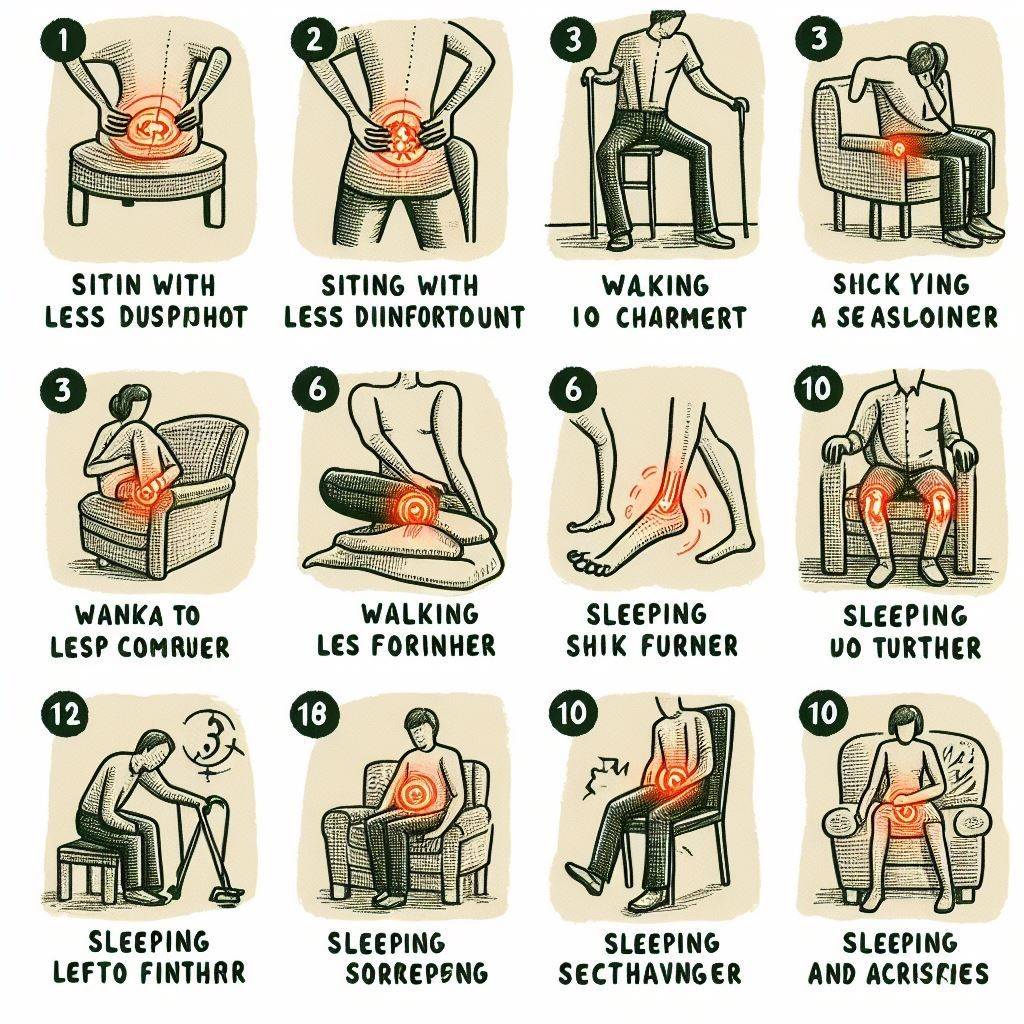10 Signs of Sciatica Improving: Roadmap to a Pain-Free Tomorrow
Discover the roadmap to relief! Explore 10 signs of sciatica improving, guiding you towards a pain-free tomorrow. Your journey to wellness starts here.
Key Takeaways on Signs of Sciatica Improving
- Watch for decreased intensity and frequency of pain episodes.
- Notice if the range of motion and flexibility improve.
- Check for the disappearance of tingling/numbness.
- Monitor the return of strength in the leg/foot
- Observe whether sitting, standing, and sleeping become easier.
- See if less pain medication is needed.
- Resuming normal activities indicates improvement.
Introduction
Signs of Sciatica Improving can give hope to those suffering from this painful condition. Sciatica refers to pain that radiates along the path of the sciatic nerve, which runs from the lower back down through the buttocks and into each leg. It often causes debilitating pain, tingling, weakness or numbness in the lower back, buttocks, and legs.
While sciatica can be extremely painful, the good news is that for most people, it goes away on its own with time. Knowing the signs of sciatica improving can give you a roadmap to recovery and a pain-free tomorrow. This article outlines 10 key improvements to watch for.
Overview of Sciatica and Its Symptoms
Sciatica occurs when the sciatic nerve becomes compressed or irritated, often because of a herniated disc in the spine or bone spurs. Symptoms include:
- Radiating pain in the lower back, buttocks, and down one or both legs
- Numbness or tingling sensations
- Muscle weakness
- Difficulty moving the leg or foot.
The pain may be mild at first, but it can become severe and debilitating. Fortunately, the outlook for most cases of sciatica is good.
10 Signs of Sciatica Improving

Monitoring your symptoms closely can help identify when your sciatica starts improving. Here are 10 positive signs to watch for:
Decreased Intensity of Pain
One of the first signs that your sciatica is beginning to improve is that the intensity of pain decreases. It may go from severe to a milder, dull ache. The periods of worst pain become shorter.
Less Frequent Pain
Along with less intense pain, you may notice that the pain episodes are less frequent. Where you once had constant pain, you now have windows of time where you are relatively pain-free.
Improved Range of Motion
As the inflammation and irritation of the sciatic nerve decrease, you may start regaining flexibility and range of motion. Simple movements like bending to tie your shoes become less painful.
Less Numbness and Tingling
When pressure on the sciatic nerve is relieved, you may have fewer numbness and tingling sensations down your leg and into your foot. The feeling starts to return to the affected areas.
More Strength Returning
Sciatica can cause weakness in the leg and foot on the affected side. As your condition improves, strength steadily returns to these areas. You can bear more weight on your legs.
Sitting Becomes Easier
Sitting is often extremely painful with sciatica. As the condition improves, you find you can sit for longer before discomfort sets in. Sitting for short periods may be nearly pain-free.
Standing Is Less Painful
Similar to sitting, standing can also aggravate sciatic pain. When sciatica resolves, many people experience less pain with standing and walking.
Better Sleep
The severe pain of sciatica can make sleep difficult. As your symptoms improve, you may find it much easier to fall asleep, stay asleep, and wake less frequently because of pain.
Pain Medication Needed Less
Relying frequently on NSAIDS, muscle relaxers, or other pain medications is common with sciatica. As your condition improves, your need for regular pain relief decreases.
Resuming Normal Activities
The final positive sign that sciatica is resolving is being able to resume normal daily activities that were interrupted by pain and discomfort. Signs of Sciatica Improving means walking farther, exercising again, returning to work, enjoying hobbies, and doing household chores. Your journey to wellness starts here.
What to Do If You Experience These Positive Signs
If you start noticing these signs that your sciatica symptoms are decreasing and improving, there are a few things you can do:
- Continue with any treatment plans recommended by your doctor, which may include anti-inflammatories, physical therapy, exercises, hot/cold therapy, etc. Don’t abandon treatments too early.
- Gradually increase activity levels and exercise, but avoid anything too strenuous that could re-aggravate the sciatic nerve.
- Monitor your symptoms closely and watch for any reversal or plateau of improvement. Report these to your medical provider.
- Use posture, proper lifting techniques, and sciatica-friendly ergonomics to prevent recurrence.
While these signs of sciatica improvement indicate you are progressing in the right direction, be sure to follow up regularly with your healthcare professional. They can confirm if your sciatic nerve is healing as expected. Most cases of sciatica resolve within a few weeks or months, but some take longer.
Are My Improving Symptoms a Sign Sciatica Is Gone for Good?
It’s perfectly normal to feel encouraged when your sciatica pain starts decreasing and you begin doing things you couldn’t do before. However, brief periods of improvement do not always mean the condition has resolved completely.
Sciatica can follow a relapsing and remitting pattern, where symptoms flare up for a time and then fade, only to return. Each person’s progression is unique. Some experience steady, linear improvement until the problem resolves fully. Others have a more unpredictable course.
The positive signs outlined in this article indicate you are heading in the right direction. But persist with any treatments your doctor advises and avoid behaviours that could re-injure the sciatic nerve. With patience and care, you can find lasting relief.
Developing a Game Plan for Recovery
Getting on the road to recovery from sciatica often takes a comprehensive plan. Here are some key elements to include in your strategy:
Continue Professional Treatments
Stick with any therapy, exercises, or medication recommended by your doctor. Don’t abandon prescribed treatments too quickly.
Utilize Home Remedies Complement professional care with sciatica-friendly home remedies like cold/hot packs, ginger supplements, gentle stretches, and over-the-counter pain medication.
Practice Good Sciatica Habits
Use posture, proper lifting form, anti-inflammatory diet, ergonomic work setup, and other sciatica-wise habits to avoid re-injury.
Exercise Caution
Increase activity gradually under your doctor’s supervision. Avoid prolonged sitting and take regular movement breaks.
Listen to Your Body Monitor your symptoms closely and watch for any regression or plateau. Report concerns promptly.
Have Patience
Allow sufficient time for inflammation and irritation to resolve fully. Most sciatica resolves within weeks or months, but recovery may take longer.
Consider Advanced Treatments. If symptoms persist despite conservative care, consult your doctor about advanced options like spinal injections or surgery.
The Sciatica Roller Coaster: Coping with Flare-Ups
One difficult aspect of sciatica is that pain levels can fluctuate, with periods of intense flares followed by times of improvement. Don’t lose hope if your progress forward is interrupted by intermittent setbacks.
Here are some tips for coping when your sciatica flares up:
- Use pain management techniques like ice/heat, massage, pain medication, gentle stretches, pain support devices, etc.
- Alter activities and movements to avoid those that aggravate symptoms. Consider a cane or brace for help.
- Focus on relief, not endurance. Give yourself permission to rest and recover.
- Practicing stress management as emotional upset can worsen pain. Try relaxing activities.
- Remember, it’s temporary. The flare will run its course. Focus on getting through just one day at a time.
- Avoid discouragement. Progress in sciatica is often “two steps forward, one step back”. Expect ups and downs.
- Lean on your support system of family, friends, and healthcare providers for extra help during flares.
- Trust your treatment plan. Stick with professional advice, even if progress feels slow. Relief will come.
When to Seek Emergency Sciatica Care
Most cases of sciatica improve with time and conservative treatment. However, in rare cases, the pain or numbness can indicate an urgent medical problem requiring emergency care. Seek help immediately if you experience:
- Loss of bladder or bowel control
- Sudden severe weakness or numbness in one or both legs
- Cauda equina syndrome signs like:
- Saddle anesthesia – loss of sensation in the groin, inner thighs, or buttocks
- Achilles tendon reflex loss
- Upper thigh or genital sensory changes
- Leg pain when coughing or sneezing.
- Bowel and bladder dysfunction
- Unexplained fever or chills, along with sciatica pain, could signal an infection.
- Difficulty breathing, chest pain, abdominal pain, or other concerning symptoms unrelated to the back or leg pain
In most cases, sciatica resolves on its own or with conservative care from your doctor. But critical symptoms like those above require urgent evaluation to rule out a serious problem. Don’t delay in seeking emergency help if you notice these issues.
Report any worsening numbness, weakness, or bowel/bladder changes to your doctor promptly as well, even if not yet severe. Catching any complications early is important. With proper treatment, most people with sciatica can get back to pain-free normal activities.
FAQS about Signs of Sciatica Improving
Here are the common frequently asked questions about signs of Sciatica Improving and the best answers for them:
How does it feel when sciatica is healing?
When your sciatica starts getting better, you’ll notice the pain isn’t as intense or constant. It may shift from a sharp, stabbing sensation to a duller ache. You’ll have a longer break between pain flare-ups. Simple movements like bending over get less agonizing. You may also regain some strength and flexibility in your leg and back. Overall, the pain gets more manageable, and your normal activities become less limited by sciatic discomfort.
How do I know sciatica is getting better?
There are a few key signs your sciatica is improving: the pain isn’t as severe, it happens less often, numbness and tingling decrease, your range of motion increases, standing and sitting get easier, your sleep improves, and you can reduce how much pain medication you need. When your sciatica is healing, you’ll start resuming more of your routine. But recovery happens gradually, so be patient through ups and downs.
When does sciatica start feeling better?
Everyone progresses at a different pace, but most people start noticing some improvement within a few weeks to a couple of months. In mild cases of sciatica, the pain may diminish within a week or two. More severe cases often take 6-12 weeks to see meaningful relief. But you may get some subtle gains earlier on, like slightly fewer stabbing sensations, more pain-free intervals, or regaining a bit of flexibility and strength. Tracking symptoms daily helps identify when sciatica is very slowly starting to feel better.
What is the last stage of sciatica?
The final stage of sciatica before full recovery is usually marked by only occasional mild aches and twitching nerves, rather than constant severe pain. The numbness and tingling have disappeared. You have minimal limitations on sitting, walking, bending, lifting, and other activities. Pain may still flare up if you overdo things, so continue sciatica-friendly habits. But you’re able to resume your normal routines. At this late stage, the healing process is nearing completion, though occasionally some symptoms can linger at low levels for an extended time before resolving entirely.
Conclusion about Signs of Sciatica Improving
Signs of Sciatica Improving, Your Guide to a Pain-Free Tomorrow
Navigating sciatica recovery may feel like a winding road, but recognizing subtle signs of improvement is key. Each small gain propels you closer to relief. Armed with progressive markers, chart your healing journey. While timelines vary, most experience steady improvement over weeks or months. With patience and persistence, you’ll traverse this path, eyes on the next positive sign. Soon, you’ll look back on a pain-free tomorrow.



